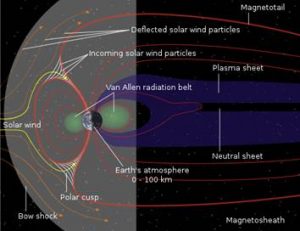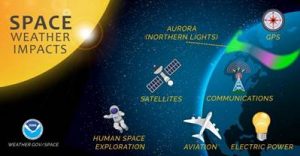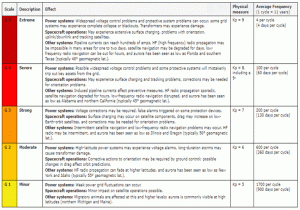THE CONTEXT: In February 2022, Elon Musk’s Starlink lost dozens of satellites that were caught in a geomagnetic storm a day after they were launched. The loss of over 40 satellites in a single solar event has been described as “unheard of” and “huge”.However, the satellites were designed to burn up on reentry into the Earth’s atmosphere and did not create debris in space. The following article explains the phenomenon of geomagnetic storms from a geographical perspective.
GEOMAGNETIC STORMS
A geomagnetic storm is a major and temporary disturbance of Earth’s magnetosphere. They occur when a surge of the solar wind (charged particles from the sun) interacts with Earth’s magnetic field and generates currents in Earth’s upper atmosphere.
The magnetosphere shields our planet from harmful solar and cosmic particle radiation, Solar Storms occur during the release of magnetic energy associated with sunspots (‘dark’ regions on the Sun that are cooler than the surrounding photosphere – the lowest layer of the solar atmosphere) and can last for a few minutes or hours.
A Solar Storm or a Coronal Mass Ejection (CME) as astronomers call it, is an ejection of highly magnetized particles from the sun. These particles can travel several million km per hour and can take about 13 hours to five days to reach Earth.
Earth is surrounded by an immense magnetic field called the magnetosphere. Generated by powerful, dynamic forces at the center of Earth, our magnetosphere shields us from erosion of our atmosphere by the solar wind, erosion and particle radiation from coronal mass ejections, and cosmic rays from deep space. Our magnetosphere plays the role of gatekeeper, repelling this unwanted energy that’s harmful to life on Earth.

- The Bow Shockoccurs when the magnetosphere of an astrophysical object interacts with the nearby flowing ambient plasma such as the solar wind. For Earth and other magnetized planets, it is the boundary at which the speed of the stellar wind abruptly drops as a result of its approach to magnetopause.
- The Polar Cuspsare near-zero magnetic field magnitude and funnel-shaped areas between field lines that map to the dayside and nightside of the magnetopause surface. They are the primary regions for direct entry of magnetosheath/solar wind plasma into the magnetosphere and may create the appearance of beautiful auroras when seen from the arctic regions of the Earth.
- Van Allen radiation belt, doughnut-shaped zones of highly energetic charged particles trapped at high altitudes in Earth’s magnetic field. The belts are most intense over the Equator and are effectively absent above the poles. The Van Allen radiation belt is a zone of energetic charged particles originating from the solar wind. The particles are captured and held around a planet by that planet’s magnetic field. It surrounds Earth, containing a nearly impenetrable barrier that prevents the fastest, most energetic electrons from reaching Earth.
IMPACT OF GEOMAGNETIC STORMS ON EARTH

ON SPACE WEATHER: Not all solar flares reach Earth, but solar flares/storms, Solar Energetic Particles (SEPs), high-speed solar winds, and Coronal Mass Ejections (CMEs) that come close can impact space weather in near-Earth space and the upper atmosphere.
ON MAGNETOSPHERE: Coronal Mass Ejections (CMEs) significantly loaded with matter traveling at millions of miles an hour can potentially create disturbances in the magnetosphere. Geomagnetic storms result in intense currents in the magnetosphere, changes in the radiation belts, and changes in the ionosphere, including heating the ionosphere and the thermosphere.
ON SPACE-DEPENDENT SERVICES: Solar storms can hit operations of space-dependent services like Global Positioning Systems (GPS), radio, and satellite communications. Aircraft flights, power grids, and space exploration programs are also vulnerable to geomagnetic storms.
ON COMMUNICATION: Geomagnetic storms interfere with high-frequency radio communications that rely on the ionosphere for propagation.
ON POWER GRIDS, OIL, AND GAS PIPELINES: When the earth is in the direct path of such solar storms, these magnetized and charged solar particles will interact with the earth’s magnetic field and induce strong electric currents on the earth’s surface that can damage long-distance cables.
ON UNDERSEA INTERNET CABLES: Undersea cables have a higher risk of failure compared to land cables due to their large lengths as current is proportional to the area of the loop formed by the two grounds and the cable.
HEALTH RISKS FOR ASTRONAUTS: Astronauts on spacewalks face health risks from possible exposure to solar radiation outside the Earth’s protective atmosphere.
FORMATION OF AURORAS: These storms can create the appearance of beautiful auroras aurora borealis (the northern lights) and aurora australis (the southern lights.)
LINK BETWEEN SOLAR STORMS AND ANIMAL BEACHINGS: Researchers from a cross-section of fields pooled massive data sets to see if disturbances to the magnetic field around Earth could be what confuses these sea creatures, known as cetaceans. CETACEANS are thought to use Earth’s magnetic field to navigate. Since intense solar storms can disturb the magnetic field, scientists want to determine whether they could, by extension, actually interfere with animals’ internal compasses and lead them astray. However solar storms may not be the primary cause of animal beaching but the research continues.
LINK BETWEEN SOLAR STORMS AND MIGRATORY BIRDS: Birds possess a magnetic sense and rely on the Earth’s magnetic field for orientation during migration. However, the geomagnetic field can be altered by solar activity at relatively unpredictable intervals. How birds cope with the temporal geomagnetic variations caused by solar storms during migration is still unclear.



CONCERNS WITH GEOMAGNETIC STORMS
- The Sun goes through an 11-year cycle – cycles of high and low sunspots activity. It also has a longer 100-year cycle. During the last three decades, when the internet infrastructure was booming, it was a low period. And very soon, either in this cycle or the next cycle, we are going towards the peaks of the 100-year cycle. So it is highly likely that we might see one powerful solar storm during our lifetime
- The rapid development of technology took place in the last three decades when the Sun was in its period of low activity and there are very limited studies on whether our current infrastructure can withstand a powerful solar storm.
GEOMAGNETIC STORMS AND INDIA
- The countries in the lower latitudes are at a much lower risk but there is a need for more studies to fully understand the effects of geomagnetic storms and the regions of lower latitudes.
- Modelled and Simulation Studies to understand how connectivity will be affected on a country-scale, showed that the majority of cables connecting India will be unaffected.
- Even under the high-failure scenario, some international connectivity remains (e.g., India to Singapore, the Middle East, etc.). Unlike in China, the key cities of Mumbai and Chennai do not lose connectivity even with high failures
- Compared to the US, India is less vulnerable, but we still need to know more about the strength of solar storms and whether a powerful one can affect India.
THE WAY FORWARD
- Shutdown Strategy:‘Shutdown Strategy’ can help minimize the connectivity loss during and after a solar storm impact. Similar to how we power off power grids, a temporary internet shutdown can protect our equipment during a solar event and ensure the continuation of services.
- Systematic Protocols:
- We need a more systematic protocol for doing this. Both NASA and the European Space Agency have probes now that can detect a solar storm and can give about 13 hours of warning.
- Experts from different fields need to come together to design protocols for power companies and internet service providers.
- Also, today’s health care system depends on power and the internet and we need to have a fallback strategy.
- With the increasing global dependence on satellites for almost every activity, there is a need for better space weather forecasts and more effective ways to protect satellites.
THE CONCLUSION: Current models are capable of predicting a storm’s time of arrival and its speed. But we are still not able to predict the storm’s structure or orientation. Independent solar observations show that solar superstorms capable of large-scale damage may occur only a few times in a century. Nevertheless, given their potential to cause large-scale disruption to our modern society, research and studies are needed to help us prepare and take steps for reducing their impact.
MAINS QUESTIONS:
- What are geomagnetic storms? What steps are needed to prepare for any possible cause of a powerful solar storm in the future?
- Explain the possible consequences of a powerful solar storm on life and property on Earth.
ADDED INFORMATION: 5 categories measure geomagnetic storms given by National Oceanic and Atmospheric Administration, USA (NOAA).


